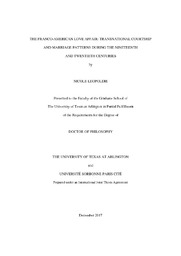| dc.description.abstract | This work deals with courtships and marriages that transcend national, cultural, and linguistic boundaries. It deals with the formation of transnational families and transnational spaces. And finally, because the historical concept of transnational marriage provides a unique prism through which to view the interconnectedness of societies at their most intimate cultural intersections, it deals with the longstanding, complex cultural relations between France and the United States during the nineteenth and twentieth centuries.
In an effort to address not only why Franco-American marriages occurred but how and why the dynamics that produced them changed over time, this work examines and compares two transnational-marriage patterns in different historical contexts: the first, when wealthy American heiresses married French aristocrats during the second half of the nineteenth century—a period marked by relatively free transatlantic circulation and mobility—and the second, when borders were far more solidified—during the world wars when French women entered into matrimonial contracts with American soldiers.
The purpose of this work is twofold: In an effort provide new categories of analysis that place the human experience into broader, more global perspectives, the first is to show how concepts of transnational marriage and courtship allow the historian to move further beyond the analytical frameworks of national histories by forcing the researcher to reconsider the ways in which one thinks about family formation and the permeability of national borders during these different stages of the national project. The second is to challenge underlying assumptions in existing historiographical explanations that those who crossed national borders to couple or to marry did so for purely socio-economic reasons. I contend that such rationalizations are simply too narrow and that at the intersection of cross-cultural encounter and transnational coupling stood a profoundly emotional experience. Therefore, greater analytical considerations need to include both cultural and emotional motivations that were always in the background.
Because the social practices of courtship and marriage became mechanisms through which borders were crossed and new cultural spaces were created, they represent important elements of transnational entanglements. Therefore, rather than examining marriage motivation from the perspective of one society or another, this work seeks to instead examine the ways in which patterns of transnational marriage emerged out of social spaces of cross-cultural encounter between the two societies. In order to identify, map, and analyze the transnational spaces that produced marriage during the nineteenth and twentieth century, this work draws on descriptions of social events found in the French and American press, travel literature, personal accounts, and guest lists. By examining where and how couples met and courted one another, these sources provide an important glimpse into not only transnational social networks and cultural rituals but also the ways in which marriage participants perceived, experienced, and interpreted these spaces. In this spatial examination, emotions are employed as a category of analysis rather than a narrative device in order to show how complex cultural meanings within transnational spaces were experienced on personal levels among transnational-marriage participants. Because a variety of emotions manifested in both encounter and representations of the “other,” I propose that othering be further considered as not simply a cultural process, but an emotional one. By drawing on French and American literary works, travel literature, and personal accounts found in unpublished and published memoirs, letters, and interviews collected by contemporary journalists and oral historians, I argue that even though marriage participants from each of the two patterns conceived of the national and cultural boundaries that separated them in very different ways, attraction to notions of difference provoked important emotional responses and largely remained the driving force of marriage and coupling processes in both historical contexts. By participating in a transnational marriage, participants bound themselves not only to their spouse but also to the culture of that spouse. Motivations for transnational marriage were, therefore, still strategic but were largely based on preconceived notions of what they believed the other culture to be. | |


